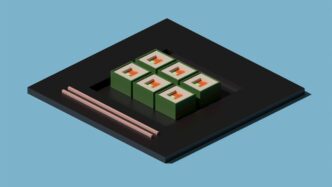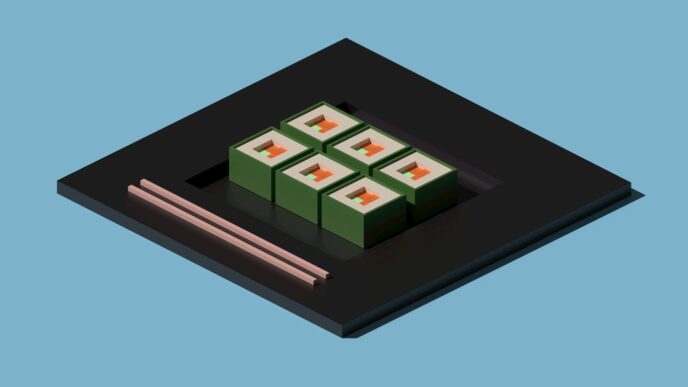So, China’s got this new quantum computer chip, right? It’s called Zuchongzhi 3, and apparently, it’s a pretty big deal. They’re saying it’s way faster than even the best regular supercomputers out there for certain jobs. It’s kind of like a new milestone in the whole quantum computing race that’s happening globally.
Key Takeaways
- The Zuchongzhi 3 is a new 105-qubit superconducting quantum processor from China.
- It reportedly achieved a significant quantum computational advantage, outperforming classical supercomputers by a huge margin on specific tasks.
- This development marks a notable step forward in China’s efforts in the field of quantum computing.
- The chip shows improvements in qubit fidelity and coherence times compared to previous versions.
- While impressive, the Zuchongzhi 3, like other quantum computers, still faces challenges in error correction for practical, widespread use.
Zuchongzhi 3: A Leap in China Quantum Computing Chip Performance
Unveiling the 105-Qubit Superconducting Processor
China has made a significant stride in the quantum computing race with the introduction of Zuchongzhi 3.0. This new superconducting quantum processor boasts 105 qubits, a notable increase from its predecessors. This development marks a new record for quantum computational advantage within superconducting systems. Researchers at the University of Science and Technology of China (USTC) have demonstrated that Zuchongzhi 3.0 can perform certain calculations at speeds that are, quite frankly, mind-boggling compared to even the most powerful classical supercomputers. It’s not just about having more qubits; the quality and stability of these qubits have also seen improvements, which is key for tackling more complex problems.
Record Quantum Computational Advantage Achieved
The Zuchongzhi 3.0 processor has achieved a remarkable feat in quantum computational advantage. In experiments involving random circuit sampling with 83 qubits, the system completed a task that would take the world’s fastest supercomputer, Frontier, an estimated 6.4 billion years. This demonstration, completed in mere seconds, represents a leap of about 15 orders of magnitude faster than classical methods for this specific problem. This isn’t just a theoretical win; it’s a practical display of quantum computers moving beyond theoretical possibilities into territory that classical machines simply cannot reach.
A Milestone in China’s Quantum Advancements
This achievement places China at the forefront of global quantum research, going head-to-head with other leading nations. The Zuchongzhi 3.0 represents a culmination of years of dedicated work and innovation in quantum physics and engineering. It’s a clear signal that China is a major player in this high-stakes technological competition. The progress seen here is not just about building a faster machine; it’s about laying the groundwork for future quantum technologies that could eventually tackle problems currently unsolvable, from drug discovery to materials science.
Technical Prowess of the Zuchongzhi 3 China Quantum Computing Chip
So, what makes the Zuchongzhi 3 chip so special? It’s not just about having more qubits, though that’s a big part of it. The real magic is in how those qubits behave and how they’re put together. The team behind Zuchongzhi 3 really focused on making things work better, faster, and more reliably.
Enhanced Fidelity and Coherence Times
Think of qubit fidelity like how accurately a coin lands on heads or tails every single time you flip it. For quantum computers, high fidelity means the qubits are less likely to make mistakes during calculations. Zuchongzhi 3 boasts some impressive numbers here. We’re talking about single-qubit gates hitting 99.90% accuracy, and two-qubit gates, which are trickier, coming in at 99.62%. Even reading out the results is pretty accurate at 99.18%.
But it’s not just about accuracy; it’s also about how long the qubits can hold their quantum state before getting messed up by outside noise. This is called coherence time. Zuchongzhi 3 has managed to extend this to about 72 microseconds. That might not sound like much to us, but in the quantum world, it’s a significant amount of time, allowing for more complex operations to be performed.
Advanced Architecture and Connectivity
The chip itself is laid out in a grid, a 15×7 array, which gives it 105 qubits in total. What’s neat is how they’re connected. With 182 couplers, the qubits can talk to each other more easily. This improved connectivity is key for running more complicated quantum algorithms. It’s like having a better network for your quantum bits to communicate.
Flip-Chip Integration for Efficiency
One clever bit of engineering they used is called ‘flip-chip’ integration. Basically, instead of connecting chips in a more traditional way, they flip one chip over and bond it directly to another. This method allows for a much denser connection between components, which can reduce signal loss and make the whole system more efficient. It’s a way to pack more power into a smaller, more effective package, using a sapphire base and special tantalum-aluminum parts to keep noise down.
The Global Quantum Computing Race Intensifies
Zuchongzhi 3 vs. Google’s Willow Processor
It feels like every week there’s a new announcement in the quantum computing world, and things are really heating up. China’s Zuchongzhi 3 chip, with its 105 qubits, is making some serious waves. But it’s not the only big player. Google recently showed off its Willow processor, also with 105 qubits. While they match in qubit count, their approaches seem pretty different. Google is putting a lot of effort into quantum error correction, aiming to make computations super reliable. They claim Willow can do a specific task in under five minutes that would take the best classical supercomputers billions of years. That’s a wild number, right?
China’s Position in Quantum Research
This Zuchongzhi 3 achievement really puts China right there at the front of the pack. It’s not just about having a lot of qubits; it’s about what they can do. The team behind Zuchongzhi 3 managed to get a million samples from an 83-qubit random circuit in just a few hundred seconds. That’s a big jump from what Google’s earlier Sycamore processor could do. It shows China is serious about pushing the boundaries, especially in superconducting quantum computers. They’ve been on a steady path, moving from 66 qubits with Zuchongzhi 2.1 to this new 105-qubit system, and it’s definitely getting them noticed on the global stage.
Diverging Strategies in Quantum Development
What’s really interesting is how different companies and countries are tackling quantum computing. It’s not a one-size-fits-all situation. While Zuchongzhi 3 is showing off its raw computational power and speed, Google’s Willow is focusing hard on error correction. Then you have companies like Microsoft, who are exploring a completely different path with topological qubits, aiming for more stable systems. It’s like everyone has their own idea of the best way to build a working quantum computer.
Here’s a quick look at some of the different focuses:
- Speed and Scale: Zuchongzhi 3 is pushing the limits of how fast and complex a computation can be. They’re using a large number of qubits to tackle problems that are just too much for today’s supercomputers.
- Error Correction: Google’s Willow is prioritizing making quantum computers reliable. This means reducing errors, which is a huge hurdle for quantum computing.
- Stability and Novel Architectures: Microsoft is looking at new types of qubits that might be inherently more stable, potentially leading to fewer errors from the start.
This variety of approaches suggests that the path to practical quantum computers might involve several different technologies working together, or maybe one will eventually prove to be the clear winner. It’s a fascinating time to watch it all unfold.
Experimental Validation and Computational Advantage
So, how do we know Zuchongzhi 3 is actually doing what they say it can? That’s where experimental validation comes in, and it’s a pretty big deal. The team tackled a task called random circuit sampling. Think of it like this: they run a bunch of random quantum operations, then measure the outcome. For regular computers, figuring out what that outcome should be gets incredibly hard, really fast, as you add more quantum bits (qubits) and operations.
Zuchongzhi 3 managed to run a circuit with 83 qubits and generate a million samples in just a few seconds. That’s a huge leap. To put it in perspective, the researchers estimate that even the most powerful supercomputer out there, Frontier, would need billions of years to do the same thing. It’s a clear demonstration that for this specific kind of problem, the quantum chip is way, way ahead.
Random Circuit Sampling Demonstrations
This random circuit sampling isn’t just some random test; it’s become a go-to method for showing off this "quantum computational advantage." The process involves applying a sequence of random quantum gates and then measuring the resulting states. The complexity for classical computers to simulate this grows exponentially, making it a tough benchmark. Zuchongzhi 3’s performance here, especially with its 83 qubits and 32 cycles, is what really stands out. It’s not just about the number of qubits, but how well they work together.
Performance Against Classical Supercomputers
When you compare Zuchongzhi 3 to classical machines, the numbers are pretty wild. The team’s random circuit sampling experiment, they figure, would take about 6.4 billion years on the Frontier supercomputer. That’s a mind-boggling amount of time. While other quantum processors, like Google’s Willow, also show impressive results, often by focusing on error suppression and logical qubit stability, Zuchongzhi 3’s approach highlights its raw computational power for these specific sampling tasks. It really underscores the gap that’s opening up between quantum and classical capabilities for certain problems.
Scaling Complexity and Qubit Count
What’s next? Well, the researchers are already looking at how to push things even further. They want to increase the number of qubits and the complexity of the circuits they can run. This isn’t just about making bigger machines; it’s about tackling more challenging problems. They’re also working on improving qubit coherence times – basically, how long the qubits can maintain their quantum state – and reducing errors. It’s a step-by-step process, but each improvement brings us closer to using these quantum computers for things that actually matter outside the lab.
Future Directions for the China Quantum Computing Chip
So, Zuchongzhi 3 is pretty impressive, right? It’s hitting these record speeds and showing what these quantum chips can do. But where does it go from here? It’s not like they just stop after hitting a new benchmark. The team behind Zuchongzhi 3 is already looking ahead, and there are a few big areas they’re focusing on.
Advancing Quantum Error Correction
One of the biggest hurdles in quantum computing is errors. Qubits are super sensitive, and even tiny disturbances can mess up calculations. Think of it like trying to have a conversation in a really noisy room – you miss bits of what’s being said. Zuchongzhi 3 is already working on this, specifically with something called a "surface code" approach. They’re trying to build up the ability to correct these errors, starting with a code distance of 7 and planning to push it to 9 and then 11. This is a big deal because it’s key to making quantum computers reliable enough for complex tasks. It’s a step-by-step process, kind of like building a sturdy house brick by brick.
Hybrid Quantum-Classical Systems
It’s unlikely that quantum computers will completely replace our current computers anytime soon. Instead, the future probably looks more like a team-up. This means creating systems where quantum computers and classical computers work together. The quantum chip handles the really tough, specific problems that it’s good at, while the classical computer manages the rest. This hybrid approach could let us tackle problems that are currently out of reach for either type of computer alone. It’s about finding the best tool for each part of a job.
Towards Practical Quantum Applications
Right now, a lot of what we see with chips like Zuchongzhi 3 are demonstrations of computational advantage. They show that the chip can do something a classical computer can’t, or would take an impossibly long time to do. But the real goal is to use this power for actual, real-world problems. This could mean breakthroughs in areas like drug discovery, materials science, or complex financial modeling. The progress made with Zuchongzhi 3 is laying the groundwork for this, moving beyond just speed tests to solving tangible challenges. It’s about turning this incredible potential into something that can make a difference. China has made significant advancements in quantum technologies, and this is just another step in that journey.
What’s Next for Quantum Computing?
So, Zuchongzhi 3.0 is a pretty big deal, showing just how far China’s quantum tech has come. It’s not just about having more qubits; it’s about them working better and faster. This definitely puts China right up there in the global race. While we’re still a ways off from using quantum computers for everyday stuff like finding new medicines or making better materials, this kind of progress is what gets us closer. It’s like building a super-fast car – you might not be driving it to the grocery store tomorrow, but it proves the engine works and points to what’s possible down the road. The next steps will likely involve making these systems even more reliable and figuring out how to tackle real-world problems, not just lab experiments.
Frequently Asked Questions
What is Zuchongzhi 3?
Zuchongzhi 3 is a super-advanced computer chip from China that uses quantum physics. It has 105 tiny parts called qubits, which are like the building blocks for quantum computers. This chip is a big step forward for quantum computing in China and around the world.
What makes Zuchongzhi 3 special?
This chip is special because it’s incredibly fast at certain types of calculations. It can do a specific job that would take the world’s best regular supercomputers billions of years, all in just a short amount of time. This shows it has a ‘quantum advantage,’ meaning it’s much better than normal computers for some problems.
How does Zuchongzhi 3 compare to other quantum computers?
Zuchongzhi 3 is a top performer, especially in doing complex tasks quickly. It’s often compared to other leading quantum chips, like Google’s Willow processor. While they both have many qubits, they might focus on slightly different things, like speed versus making sure calculations are super accurate.
What are qubits?
Qubits are the basic units of information in quantum computers. Unlike regular computer bits that are either 0 or 1, qubits can be 0, 1, or both at the same time. This ‘superposition’ allows quantum computers to explore many possibilities at once, making them powerful for certain tasks.
Why is quantum computing important?
Quantum computers could help us solve really hard problems that are impossible for today’s computers. This includes discovering new medicines, creating advanced materials, improving artificial intelligence, and making complex financial systems more efficient. It’s like having a super-powered calculator for the world’s toughest puzzles.
What’s next for quantum computers like Zuchongzhi 3?
Scientists are working on making quantum computers even better. This means having more qubits, making them more accurate, and figuring out how to fix errors that happen during calculations. The goal is to build quantum computers that can solve real-world problems reliably and help us make amazing new discoveries.














